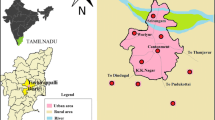Abstract
Lead is a commonly monitored heavy metal because of potential health effects on exposed organisms. We quantified lead in secondary feathers of two passerine bird species, clay-colored thrushes (Turdus grayi) and great-tailed grackles (Quiscalus mexicanus), from an urban and a rural site in the municipality of Merida, Yucatan. Urban lead concentration was significantly higher than its rural counterpart for both species (p < 0.05). In the urban site, lead concentration was similar in both species (p = 0.14). However, data from the rural site showed that lead concentration was significantly higher in thrush feathers (p < 0.05). Lead levels herein presented are among the lowest ever reported suggesting that either lead accumulation or absorption is limited. Finally, our data seem to support the hypothesis that species feeding ecology plays a major role in lead accumulation.

Similar content being viewed by others
References
Abbasi N, Jaspers V, Chaudhry M, Ali S, Malik R (2015) Influence of taxa, trophic level, and location on bioaccumulation of toxic metals in bird’s feathers: a preliminary biomonitoring study using multiple bird species from Pakistan. Chemosphere 120:527–537. doi:10.1016/j.chemosphere.2014.08.054
Adout A, Hawlena D, Mamam R, Paz-Tal O, Karpas Z (2007) Determination of trace elements in pigeon and raven feathers by ICPMS. Int J Mass Spectrom 267:109–116. doi:10.1016/j.ijms.2007.02.022
Agency for Toxic Substances and Disease Registry (ATSDR) (2007) Toxicological profile for Lead. U.S. Department of Health and Human Services. http://www.atsdr.cdc.gov/toxprofiles/tp13.pdf. Accessed 4 Nov 2013
Battaglia A, Ghidini S, Campanini G, Spaggiari R (2005) Heavy metal contamination in little owl (Athene noctua) and common buzzard (Buteo buteo) from northern Italy. Ecotoxicol Environ Saf 60:61–66. doi:10.1016/j.ecoenv.2003.12.019
Bauer-Gottwein P, Gondwe B, Charvet G, Marín LE, Rebolledo-Vieyra M, Merediz-Alonso G (2011) Review: the Yucatán Peninsula karst aquifer, Mexico. Hydrogeol J 19:507–524. doi:10.1007/s10040-010-0699-5
Berglund A, Klaminder J, Nyholm E (2009) Effects of reduced lead deposition on pied flycatcher (Ficedula hypoleuca) nestlings: tracing exposure routes using stable lead isotopes. Environ Sci Technol 43:208–213. doi:10.1021/es801723q
Bollhöfer A, Rosman KJR (2001) Isotopic source signatures for atmospheric lead: the Northern Hemisphere. Geochim Cosmochim Acta 65:1727–1740. doi:10.1016/S0016-7037(00)00630-X
Brown RE, Brain JD, Wang N (1997) The avian respiratory system: a unique model for studies of respiratory toxicosis and for monitoring air quality. Environ Health Perspect 105:188–200. doi:10.1289/ehp.97105188
Burger J, Gochfeld M (1996) Heavy metal and selenium levels in Franklin’s gull (Larus pipixcan) parents and their eggs. Arch Environ Contam Toxicol 30:487–491. doi:10.1007/BF00213400
Campbell LM, Norstrom RJ, Hobson KA, Muir DC, Backus S, Fisk AT (2005) Mercury and other trace elements in a pelagic Arctic marine food web (Northwater Polynya, Baffin Bay). Sci Total Environ 351–352:247–263. doi:10.1016/j.scitotenv.2005.02.043
Carpene E, Andreani G, Monari M, Castellani G, Isani G (2006) Distribution of Cd, Zn, Cu and Fe among selected tissues of the earthworm (Allolobophora caliginosa) and Eurasian woodcock (Scolopax rusticola). Sci Total Environ 363:126–135. doi:10.1016/j.scitotenv.2005.06.023
Cecil KM, Brubaker CJ, Adler CM, Dietrich KN, Altaye M, Egelhoff JC et al (2008) Decreased brain volume in adults with childhood lead exposure. PLoS Med 5:e112. doi:10.1371/journal.pmed.0050112
Ek KH, Morrison GM, Lindberg P, Rauch S (2004) Comparative tissue distribution of metals in birds of Sweden using ICP-MS and laser ablation ICP-MS. Arch Environ Contam Toxicol 47:259–269. doi:10.1007/s00244-004-3138-6
Elphick C, Dunning JB, Sibley DA (2001) The Sibley guide to bird life & behavior. Alfred A. Knopf, New York
Erickson B (2003) Lead paint on former military bases poses risks to wildlife. Environ Sci Technol 37:277A–278A. doi:10.1021/es032533o
Esselink H, van der Geld FM, Jager LP, Posthuma-Trumpie GA, Zoun PE, Baars AJ (1995) Biomonitoring heavy metals using the barn owl (Tyto alga guttata): sources of variation especially relating to body condition. Arch Environ Contam Toxicol 28:471–486. doi:10.1007/BF00211630
Frantz A, Pottier MA, Karimi B, Corbel H, Aubry E, Haussy C, Gasparini J, Castrec-Rouelle M (2012) Contrasting levels of heavy metals in the feathers of urban pigeons from close habitats suggest limited movements at a restricted scale. Environ Pollut 168:23–28. doi:10.1016/j.envpol.2012.04.003
Fritsch C, Coeurdassier M, Faivre B, Baurand P, Giraudoux P, van de Brink N, Scheifler R (2012) Influence of landscape composition and diversity on contaminant flux in terrestrial food webs: a case study of trace metal transfer to European blackbirds Turdus merula. Sci Total Environ 432:275–287. doi:10.1016/j.scitotenv.2012.06.004
Getz LL, Best LB, Prather M (1977) Lead in urban and rural songbirds. Environ Pollut 12:235–238. doi:10.1016/0013-9327(77),90058-1
Grubbs FE (1969) Procedures for detecting outlying observations in samples. Technometrics 11:1–21. doi:10.1080/00401706.1969.10490657
Lind Y, Bignert A, Odsjö T (2006) Decreasing lead levels in Swedish biota revealed by 36 years (1969–2004) of environmental monitoring. J Environ Monit 8:824–834. doi:10.1039/b517867c
Martin AC, Zim HS, Nelson AL (1951) American wildlife & plants: a guide to wildlife food habits: the use of trees, shrubs, weeds, and herbs by birds and mammals of the United States. Dover Publications, New York
Pain DJ, Meharg AA, Ferrer M, Taggart M, Penteriani V (2005) Lead concentrations in bones and feathers of the globally threatened Spanish imperial eagle. Biol Conserv 121:603–610. doi:10.1016/j.biocon.2004.06.012
Peraza MA, Ayala-Fierro F, Barber DS, Casarez E, Rael LT (1998) Effects of micronutrients on metal toxicity. Environ Health Perspect 106:203–216
Rodriguez-Ramos J, Höfle U, Mateo R, Nicolas O, Abbot R, Acevedo P, Manuel J (2011) Assessment of lead exposure in Spanish imperial eagle (Aquila adalberti) from spent ammunition in central Spain. Ecotoxicol 20:670–681. doi:10.1007/s10646-011-0607-3
Roux KE, Marra PP (2007) The presence and impact of environmental lead in passerine birds along an urban to rural land use gradient. Arch Environ Contam Toxicol 53:261–268. doi:10.1007/s00244-006-0174-4
Scheifler R, Coeurdassier M, Morilhat C, Bernard N, Faivre B, Flicoteaux P, Giraudoux P, Noël M, Piotte P, Rieffel D, de Vaufleury A, Badot PM (2006) Lead concentrations in feathers and blood of common blackbirds (Turdus merula) and in earthworms inhabiting unpolluted and moderately polluted urban areas. Sci Total Environ 371:197–205. doi:10.1016/j.scitotenv.2006.09.011
Schipper A, Wijnhoven S, Baveco H, van de Brink N (2012) Contaminant exposure in relation to spatio-temporal variation in diet composition: a case study of the little owl (Athene noctua). Environ Pollut 163:109–116. doi:10.1016/j.envpol.2011.12.020
USEPA (2007) EPA method 6020 A. Inductively coupled plasma mass spectrometry. http://www.epa.gov/osw/hazard/testmethods/sw846/pdfs/6020a.pdf. Accessed 30 Nov 2009
Vidal-Astudillo VJ (2007) Observaciones del comportamiento de forrajeo y reproductivo de la Mirla ollera Turdus ignobilis (Aves: Turdidae) relacionado con la precipitación en el Corregimiento Villa Carmelo-Valle del Cauca. Dissertation, Universidad del Valle
Wrobel K, deNicola K, Wrobel K, Caruso JA (2004) ICP-MS: metals and much more. In: Ashcroft AE, Brenton G, Monagham JJ (eds) Advances in mass spectrometry, 1st edn. Elsevier Science, The Netherlands, pp 231–275
Acknowledgments
This research was performed conforming to Mexican regulations and laws under permit provided by SEMARNAT (Secretaría del Medio Ambiente y Recursos Naturales) Permit Number SGPA/DGVS/12648/13. Funding was provided by Conacyt (Consejo Nacional de Ciencia y Tecnología), Project No. 133090. We thank Merida’s City Council for support during fieldwork.
Author information
Authors and Affiliations
Corresponding author
Rights and permissions
About this article
Cite this article
Nava-Diaz, R., Hoogesteijn, A.L., Erosa, M.D. et al. Comparative Study of Lead Concentration in Feathers of Urban and Rural Passerines in Merida, Mexico. Bull Environ Contam Toxicol 95, 470–474 (2015). https://doi.org/10.1007/s00128-015-1628-z
Received:
Accepted:
Published:
Issue Date:
DOI: https://doi.org/10.1007/s00128-015-1628-z




